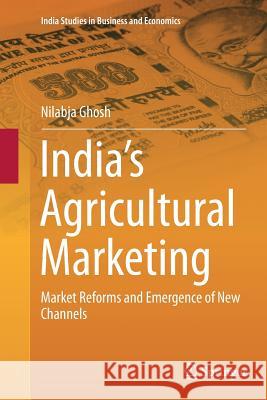India's Agricultural Marketing: Market Reforms and Emergence of New Channels » książka
India's Agricultural Marketing: Market Reforms and Emergence of New Channels
ISBN-13: 9788132234951 / Angielski / Miękka / 2016 / 311 str.
The proposed book provides an assessment of an important yet controversial policy initiated by the government of India and the governments of several other developing countries. Marketing reforms, it is claimed, can be a crucial answer to solving the problem of rural poverty in agrarian economies where large sections of the populace are engaged in low paying agricultural work. On a wider front, these reforms could help in providing growth impetus to an economy and even the global economy at large. Yet, the subject of liberalizing agricultural markets is also part of a broad and perhaps a bitter political debate between national and sub-national policymakers and across academic discourses in India and other countries. A clearer understanding and a possible resolution of the issues involved will be decidedly useful. The experience of India, one of the largest and most agriculturally dominated economies, will undoubtedly provide valuable lessons not only for steering the domestic economic policy but for helping other countries to set their own policy agendas. The book brings together contemporary empirical evidence on reforms from various states in India shortly after reforms picked up.
Opening up agricultural markets to free market forces while also giving space to new players to enter the market is expected to reduce marketing costs, which form an unproductive wedge between what the producer receives and what the consumer pays. The entry of more resourceful and larger entities to mediate in the market and the emergence of many new channels will help farmers gain access to technology to boost their productivity. The competitive environment will also encourage the existing players to rise to the occasion or to pursue other, more suitable avenues. The channels are likely to bring the producer and consumer closer, not only to reduce the price dispersion but also to fine-tune supply to the varied demands of users. On the other hand, there are dark apprehensions of the same changes benefiting only exclusive, privileged farmers, leaving out the small and resource-poor ones; about possible exploitation of farmers encountering much more powerful buyers than the erstwhile traders; regarding agro-ecological degradation accelerated by short-term profit motives; and above all there are concerns surrounding the fate of the unorganized traders who are thought to be inefficient under the present milieu. The spectre of unemployment is also a serious potential obstacle. The dilemma presented by the channels can only be viewed in perspective if both welfare and efficiency aspects are assessed in terms of real-life experience. The book attempts to capture the evolving reality in a large and diverse country and to present an objective evaluation to enable aspiring investors and those active in policymaking, the food business and civil society to make more informed assessments and decisions."











